Episode 196
What you’ll learn in this episode:
- How the artists represented by BABS translate their artistic vision to jewelry
- Why showing art and jewelry outside of the traditional gallery setting can make it less intimidating for non-collectors
- Why artist jewelry has yet to catch on with Italian consumers, and how Barbara hopes the industry evolves
- Why Barbara thinks there should be no division between art and art jewelry, and how she is trying to solve this issue
- What Barbara looks for in the pieces she selects for her gallery
About Barbara Lo Bianco
Barbara Lo Bianco is the CEO and Owner of BABS (Beyond Art Before Sculpture) Art Gallery in Milan, Italy. An art enthusiast with a long-time passion for artist jewelry, Barbara opened BABS in October 2018. As the first gallery in Italy dedicated to artists’ jewels, BABS collaborates with contemporary artists to create wearable art.
Photos:
Jessica Carroll, ring, “il volo” bronze
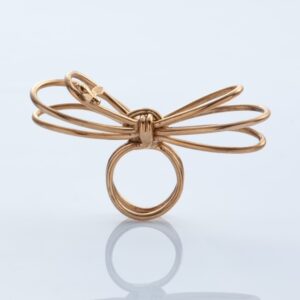
Alfredo Rapetti Mogol, earrings, “?!” titanium, gold, lapis
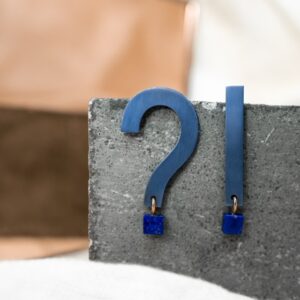
Davide Bramante, ring, “pentagon obsession”, bronze, oxidiane and rock cristal
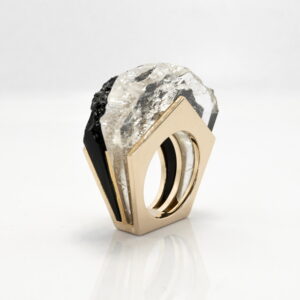
Daniele Papuli, necklace, “metrina”, paper and silver
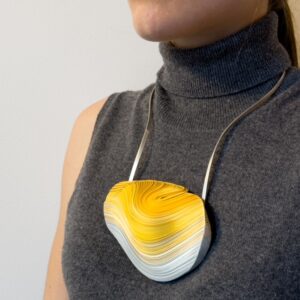
Alessandro Busci, necklace, “iceberg”, silver, gold, enamel, aquamarine
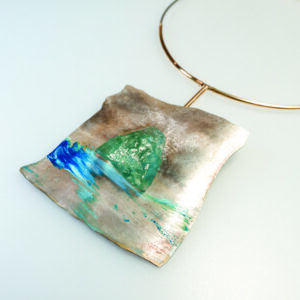
Chiara Dynys, ring, “a stone in a cage”, silver, bronze and amethyst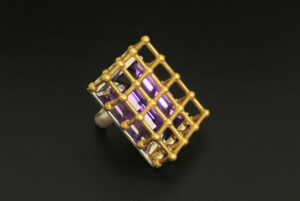
Alex Pinna, ring, “how deep is your love”, ebony and gold
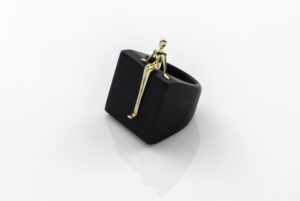
Additional Resources:
- Website: www.babsartgallery.it
- Artists Page: https://www.babsartgallery.it/maestri-gioiello-milano/
- Barbara’s LinkedIn: https://www.linkedin.com/in/barbara-lo-bianco-a1330a/
- Instagram: https://www.instagram.com/babsartgallery/
- Facebook: https://www.facebook.com/babsartgallery.gioiellidartista/
- Twitter: @BabsGallery
Transcript
Barbara Lo Bianco’s mission is to smash the arbitrary line that divides art and jewelry. As owner of BABS (Before Art Beyond Sculpture) Art Gallery in Milan, she works with fine artists to create their first pieces of jewelry and translate their vision to a new medium, breaking all the rules of what art or jewelry are supposed to be. Barbara joined the Jewelry Journey Podcast to talk about how she’s trying to change the way art jewelry is displayed at fairs; the types of artists she likes to represent; and some of her favorite pieces from BABS. Read the episode transcript here.
Sharon: Hello, everyone. Welcome to the Jewelry Journey Podcast. This is the second part of a two-part episode. If you haven’t heard part one, please head to TheJewelryJourney.com.
We’ve had a lot of entrepreneurs on The Jewelry Journey. Barbara Lo Bianco is an entrepreneur, but in a different category. Her forays before art and jewelry and having a gallery were in unrelated fields. She was involved in a fitness center and was a real estate investor. Welcome back.
I look at art. I give a cursory glance at the art that might not be at a gallery, let’s say, but at a jewelry store. It’s decoration, but it’s not to sell.
Barbara: You see a lot of restaurants in Milan that exhibit artworks by artists that are just there for the exhibition, so I think Italians are more acquainted with it. They do see it, and they might even ask questions because it’s another environment. They’re talking to somebody that is not doing that for business. They knew I was not going to sell to them. I was just saying, “You like it? Look, this is the business card of the artist. Just call him.” They feel free to ask him questions about it.
Sharon: That is different. It’s different from the experience I’ve had here. How do you divide historical contemporary from contemporary? I was surprised to see on your website what I would consider contemporary, but they were maybe historical. You had some Dalí. I can’t remember exactly.
Barbara: Yeah, we have Dalí. You cannot say it’s contemporary. He’s dead, so I cannot work with him anymore, unfortunately. He was last century. He’s modern; he’s not contemporary. There is this small distinction between modern and contemporary. There are some artists that are modern and others that are contemporary. Contemporaries are the ones that are living now and the ones that are working still. Those who are no longer working cannot be called contemporary. They are modern, yes, but they’re not contemporary.
Then there are some that are contemporary, but they’re already established. Some others are emergent or mid-career. What I’m focusing on now is mid-career, moving a little bit towards established. I’m between that field. I don’t do emerging, and I don’t do contemporary jewels. I do contemporary art, yes.
Sharon: It seems like a tremendous incentive. They show their art and a jewel or two they have made for you, and they talk with people who are aficionados.
Barbara: Yes, what is nice is that when we finish the project with the artist, we do an exhibition. I do exhibit works the artist is usually known for so you can recognize his style; you can recognize his message alongside the jewels he or she created. You can see the starting point or the inspiration point and the actual work they did, the new project, which is not often just a small reduction. It is something else, but you can still recognize the style and the message of the artist.
They do come to the exhibition, of course; they do speak with the people, but during the period of the exhibition, I always try to organize another talk or some sort of small event by appointment. There are 20, 40 people at most, so they get a chance to talk with the artist and ask them questions if they want—even if, most of the time, artists like to have their works speak for them. They are not so keen on speaking, especially in a larger group. In a small group, it works better.
Sharon: Do people see the connection?
Barbara: Yes, once they see them outside, they do. You do understand it. If you see the work by itself, it probably is not that easy, but if you see the works alongside the jewels, you do see the same end, the same meaning. It is like a speech that works within different media.
Sharon: Would you give us an example where you saw the connection?
Barbara: For example, there is an artist we work with. She made a sculpture which is about two meters high. It was treated as if it were a mirror in a bronze cage in front that looked like a medieval prison. So, you walk in front of this sculpture and suddenly you see yourself within a prison. You should start asking yourself, “Am I free or not? Why do I see myself within a cage?”
The piece of work is called The Golden Cage, because even if we are free, we are actually closed in a golden cage, more or less, because of all the limitations we give ourselves, because of all the routine, because of all the relations we have, because of all the boundaries we give ourselves, because of where our family or our business or our everyday life leads us. We wanted to give the same idea within a jewel.
It was quite hard because of the sizes. You cannot reflect yourself entirely within a cage. We tried and it came out very nice, but then we had an idea, “O.K., why don’t we put something precious in it?” We started putting in a precious stone, and that gave the message. The stone doesn’t get any light from anywhere, so it doesn’t follow the rules of jewelry where you have to give light to stone; you have to embellish it; you have to make it shiny; you have to show that it’s worth it. In this case, we put this stone within a cage, and it doesn’t get any light from anywhere. You can see it because it’s huge. The message is no matter how beautiful you are, you can never shine if you are within a cage. So, you get the same feeling; you get the same taste of the poetry of the artist, but in a different way.
Sharon: Do the artists you exhibit have favorite stones that they work with more than others?
Barbara: It depends. Some of them don’t want to work with any type of stone. Some work with stone. It depends. They are totally free. Another one is Alex Pinna. His bigger sculptures are usually made in big rope, like the ones for boats and other ships. We made the jewels with ebony, gold, silver, even rope. They give exactly the same feeling of his sculptures but made in a different way and with different shapes. He makes mixed sculptures. He’s a little bit individual. He makes these very thin human beings, but not in detail, that are sort of waiting for something that will happen or just happened; you don’t know. He captured exactly the same sense of being suspended in his sculptures and in his jewels.
Sharon: Do you tell the artist what you’re looking for? Do you tell them, “I want bracelets”?
Barbara: No.
Sharon: You don’t tell them. They have free reign.
Barbara: I tell them, “Don’t try to do what is easy; try to do what you think would be good, and leave it to me and the goldsmith to try to figure out the way to realize it. Don’t go for the easy thing.” The medallion would be the easiest way, but it’s banal; it’s something that has been seen tons of times. I think that in some way, art has to go beyond, has to go a little bit further. That’s what I tell them.
Sharon: It’s in your name, Beyond Sculpture.
Barbara: Yeah, that’s right.
Sharon: When I hear the word unique, it means I won’t see anything like it. Is that different at your gallery?
Barbara: No, that’s right. We work with unique pieces, unique within a series, or we work with very small editions. That means if it is unique, it is just one piece and that’s it. No way are we ever going to have another one again. If it is unique within a series—for example, we worked with one artist that made 13 rings which were all similar, but all very different. They are unique within a series. The series is of those 13 rings, but they are all different from one another. They differ in color. They differ in material. They are different in treatment. They are different because one might be made with enamel; the other might be without. It depends.
Otherwise, it can be a small series. We usually work with eight pieces because in the sculpture world it can still be defined as unique, but we do declare that it is one out of eight or two out of eight. In some cases, we talk with the artist, especially if they want to make the price a little bit lower. We might be working with a series of 20 or 30. In three cases, we did something for charity, so we worked in a series of 99.
Sharon: Do your artists care if it’s a unique piece? Is it important to them that they have a small series of 12 or eight?
Barbara: Some of them do want to keep it unique or in a very small series because that’s how they work with their art. Some others don’t mind. For example, Emilio Isgrò, who is one of the most accredited artists in Italy now, didn’t mind working with the larger series. So, we worked with 30 pieces. He doesn’t really mind. If it helps spread it and makes it something people would wear more, let’s do it. It depends.
Sharon: Do your clients come from all over Europe or from Italy?
Barbara: We have clients from Japan, from the U.S., from Canada, from the U.K., Belgium. We do work everywhere because with the technologies now, that’s a little bit easier. With some clients, they ask us to ship it. We wear it and do some videos to show how the ring looks or how the necklace looks, and then we ship it. We are doing some fairs. Last year we did Basel, the design fair. We had great contacts and clients from all over the world. It depends.
Sharon: You did Design Basel?
Barbara: Sorry if I interrupted you. Actually, I might say that more clients are foreigners than Italians. The Italians are still a little bit more toward traditional jewels.
Sharon: I’m surprised to hear that.
Barbara: Yes, there’s still not too much of a culture for artist jewelry.
Sharon: Do you see that changing?
Barbara: There’s a little bit more interest, but it’s still quite hard because in Italy there’s the tradition. Jewelry is often a present, and jewels by artists is something you buy for yourself because it’s a liaison between you and the artist and the piece of art. Usually if somebody gives it to you, it’s because they know you very well; they know you like that artist. Otherwise, no. It is a little bit harder that way. Italian women especially don’t buy too many jewels by themselves.
Sharon: So, most of the jewelry you’re seeing is run of the mill, the kind you’d give as a gift. It’s not what you carry.
Barbara: Yeah.
Sharon: O.K.
Barbara: What were you asking before?
Sharon: I was just going to ask what your dream would be for the business, what the next step is.
Barbara: The next step is to keep working with major artists. The thing I would really like is to make it easier to exhibit at fairs. Last year, as I was telling you, we exhibited at Basel, but we were in the bazaar in the pavilion, because the business was considered an applied art, which I don’t think is fair. It is art. It is just a small size that can be worn. The same artists that were exhibiting their jewelry, they were in the art pavilion with other works of art. Why can’t they stay together? That’s one thing.
Another thing is that they often tell me, “No, you have to exhibit either the piece of art or the jewelry,” and I don’t see why. Art should have no limits. If it is an art exhibit, it is art. That’s something I’m really trying to make the curator of the fairs understand, but it’s hard.
Sharon: That sounds like a big hurdle, a big one to get over and get past.
Barbara: Yeah, I don’t see why. We had pieces from artists and their other artwork was on the other side. We had Gilardi, and Gilardi was on the other side. Why can’t they be in the same space, in the same location? Applied art doesn’t mean it’s less valuable than normal art.
Sharon: That’s interesting. It’s been about four years since the first time we talked to you. I hope by the next time, you will have resolved a lot of these issues.
Barbara: Thank you. I’ll try.
Sharon: Thank you very much.
Barbara: I’ll keep trying. Thank you very much for having me. It was a pleasure to see you again.
Sharon: It’s nice to see you. Thank you. We will have photos posted on the website. Please head to TheJewelryJourney.com to check them out.
Thank you again for listening. Please leave us a rating and review so we can help others start their own jewelry journey.

